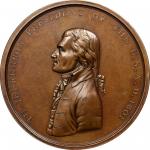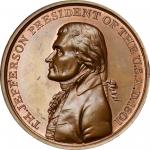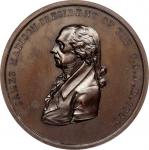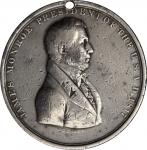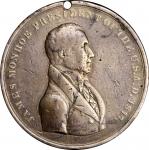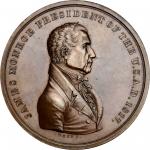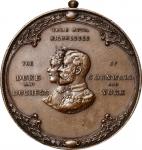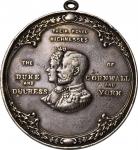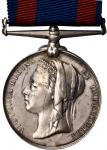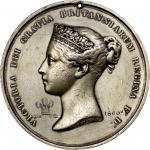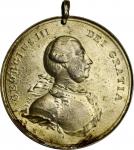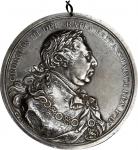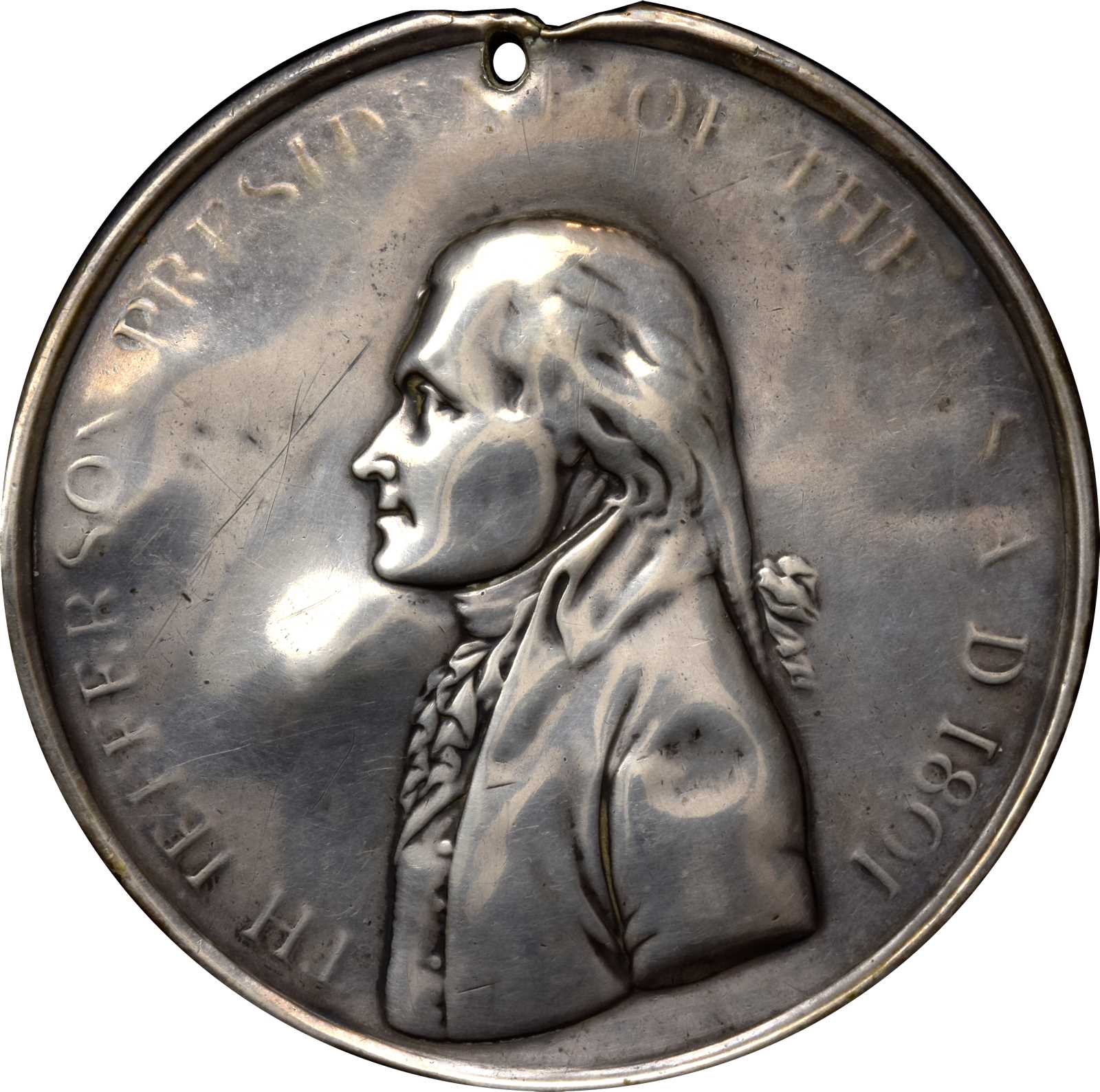1801年托马斯印第安和平奖章 极美
1801 Thomas Jefferson Indian Peace Medal. Silver Shells. First Size. Julian IP-2, Prucha-38. Very Good. 100.7 mm. 1986.25 grains. The Jefferson Peace medals are distinctive within the American series for their unusual tripartite construction. This method of manufacture allowed for the desired sizes, especially this largest variant, which might not have been possible otherwise at the time. However, it also resulted in finished medals that proved relatively fragile. The obverse and reverse pieces bearing the designs were each individually struck at the Mint on thin silver sheets. In each case, this was accomplished by the impression of a single steel die likely opposed by some relatively soft material such as wood or leather that would resist the die, yet give enough to allow for the designs to be imparted. They were not struck by two steel dies in opposition, and the clearest evidence for this is the general lack of crispness in the design features. Once the obverse and reverse shells were made, they were hand-assembled into a single medal by way of an edge band that was fused around the circumference. The band was not part of the formation of the rim on either side, but was joined at the outer edges of the raised rims. The separations in this medal clearly reveal where the pieces were joined. Finally, a simple loop hanger was affixed to the edge. There has been commentary and speculation about what was used to fill the hollow shells and we suspect that the answer is nothing at all. We can see into this medal and there are no visible remnants of any interior filler and while it is coming apart in places, it is not wide enough apart for some interior wood form (as has been proposed) to have fallen out. Even if rot had occurred to such a wood form, remnants would continue to lose dust or fragments. The same would be true of a beeswax core. Had such dried and crumbled, it would undoubtedly still be producing grains from the interior, yet nothing falls from this piece or rattles within.As alluded to above, this piece has been rather well worn. The frame is prominently bent at the edge, near 9:00 relative to the obverse, likely a primary cause of the rim separations. The obverse shell has separated from the edge band from this bend downward, around the lower half of the medal, and nearly to 3:00. A similar separation on the reverse extends from the same bend to about 6:00, where another less pronounced rim bend is noted. At this position (6:00 relative to the reverse), the edge band has split slightly and cleanly, perhaps revealing where the band was originally closed. A few notable dents are seen on this side, the deepest is along the index finger of the left hand, a dent that is sharply embossed through the obverse.The original hanger is long gone, with a somewhat jagged opening where it was once attached, though long use has smoothed the likely once rough edges. Upon the loss of the hanger, the medals owner had it pierced so that its ongoing personal display would not be interrupted. Undeniable wear is seen in this suspension piercing, suggesting that it was worn a long time after the loss of the original hanger. The surfaces of the medal are gently polished, as typical, with soft champagne and pale blue toning in the outermost fields accenting the otherwise light to medium gray silver. A few fine scratches are noted left of Jeffersons portrait.While the method of manufacture would have created objects that would have easily survived in collectors cabinets, the hard use Peace medals would be subjected to on the Great Plains and beyond proved too much for many Jefferson medals. As a result, it is likely that many simply fell apart and were lost. Others were salvaged by various repairs and a few have survived in rather fine condition. In some ways, this one is ideal. It shows the evidence of the rough wear these endured as prized adornments and proudly worn statements of status. Meanwhile, the failures of the fragile construction are serious enough to clearly reveal the details of this interesting structure, yet all of the parts are present and firmly connected around about 40% of the circumference. The medal shows no evidence of repair and is thus in its completely natural state. This alone has value to purists, as the quality and condition hide nothing. It is exactly as it should be and, in fact, it is a rather handsome example of this immensely historic artifact.After the completion of the Louisiana Purchase in 1803, it was deemed necessary to map the new territory, discover what resources existed within it, and to establish the United States as the dominant presence therein before any competing European nation could gain a meaningful foothold. Consideration of the sovereignty of the indigenous populations does not seem to have factored into any long-term planning, but making inroads with native peoples encountered along the way and, ideally, the establishment of alliances, were certainly seen as essential to Euro-American progress. The primary effort to make all this happen was called the Corps of Discovery Expedition, though it is far better known today by the names of the two men who led it. Thomas Jefferson appointed Captain Meriwether Lewis as the leader who, in-turn, selected as his junior officer Second Lieutenant William Clark. Their famous expedition commenced in May 1804 at Pittsburgh, took them to the Pacific Coast at Fort Clatsop, near the mouth of the Columbia River, and ended in St. Louis, in September 1806.The Spanish, French and English had well established the tradition of the Peace medal, and it was broadly accepted among indigenous people. It was a tradition continued by the Americans, so it was fitting that Lewis and Clark should carry official medals for presentation on behalf of the Jefferson administration to chiefs they would contact along their route. These were given along with various other trade goods that native peoples had become accustomed to receiving. It is known that medals of five sizes were carried and distributed. There were Jefferson medals in three sizes, this being the largest and reserved for the highest-ranking chiefs. The medals of the fourth size were the Washington Seasons medals, and it is believed that the fifth size consisted of American silver dollars. While we know that Lewis and Clark distributed some of these medals, they did not distribute all of them. We know of one, for example, that was presented on behalf of Jefferson to a Cherokee Chief, Thomas Chisholm, in 1808. That medal is believed to still exist in the collection of the Oklahoma Historical Society. Many others were ordered well after the completion of the Lewis and Clark Expedition.The present medal comes with a very intriguing, if incomplete, history. It was presented by Frank Hiscock to the Fort Leavenworth Museum in Kansas, in 1963, along with an 1865 Andrew Johnson medal, and presumably displayed there for a time. These two medals were written up in the Winter 1971 edition of the journal, Kansas History: A Journal of the Central Plains</em> (Vol. 37, No. 4), in an article by United States Army Colonel Donald J. Delaney. The article was primarily focused on a life portrait of Brigadier General Henry Leavenworth, the man who sited the eventual Fort Leavenworth and for whom it is named. The miniature portrait was painted by George Caitlin in 1834, and the Museum had long known of it and desired to acquire it. Correspondence with Hiscock established connections between the museum and further descendants of Leavenworth, resulting in the eventual acquisition of the portrait. Hiscock was the great-great grandson of Colonel Jesse Leavenworth. Colonel Leavenworth was the son of Brigadier General Henry Leavenworth.According to a captioned illustration in the article, this Jefferson medal was presented to a Comanche Chief, Eagle Feather, by the senior Leavenworth. However, General Leavenworth was not in the area of the traditional lands of the Comanche at the time the Jefferson medals would have been distributed. He was raised in Vermont, studied Law in New York and then engaged in the private practice of Law before entering military service in 1812. He served in the War of 1812, in which he was wounded at the Battle of Niagara in 1814. He served in the New York Assembly in 1816. He did become an Indian Agent at Prairie du Chien for a short time, but this was a couple of years after the last of the Jefferson medals would have been in distribution. His other relations with Native Americans would not likely have positioned him as a presenter of medals, as he is credited with military campaigns against the Arikara and Pawnee in the early 1820s; the success of these campaigns earned him promotion to Brigadier General. At the time of his death in 1834, he was on a campaign against the Comanche. As previously mentioned, Leavenworth is most famous for selecting the location and setting up the first encampment in May 1827, at what would become Fort Leavenworth. He does not seem to have ever been in a position or place to award a medal such as this one.Colonel Jesse Leavenworth is also referenced in the journal article as having presented the aforementioned Johnson medal to Eagle Feather, the same Comanche Chief. Therein, it is noted as "regrettable that up to this time it is not known how both of the Peace medals came to be returned to Col. Jesse Leavenworth to become family heirlooms." We have been unable to find any reference to a Comanche Chief by this name and it seems quite unlikely that a Chief of such standing as to have been the recipient of both Jefferson and Johnson medals would not be easily found in the historical record.Colonel Leavenworth was born in 1807, and followed in his fathers career path. He was a graduate of West Point in the class of 1830, and served for a time near Denver, Colorado. He left military service in 1836, but was called back upon the outbreak of the Civil War and served for less than two years before his honorable discharge. After the War, he served for about six years as an official Indian Agent to the Southern Cheyenne, Kiowa and Comanche, which places him in the right time and place to have presented an Andrew Johnson medal. His guide and interpreter while he was Indian Agent was Jesse Chisholm, who may be the best prospect as a direct holder of this Jefferson medal and the conduit by which it entered the Leavenworth family. Chisholm was very active in the area and an important enough historical figure that a book has been written about him, Jesse Chisholm Ambassador of the Plains, </em>by Stan Hoig. Chisholm had spent time with the elder Leavenworth, probably also as a guide. Being of Cherokee descent, he continued to live and trade among the local native populations, after the Generals passing and between his associations with the two Leavenworths. The Junior Leavenworth had this to say about Chisholm: "[he] has been with these Indians almost all the time since. He has been upon that frontier; he has traded with them; he speaks their language perfectly…and has helped me more since (1864) than anyone else in keeping them quiet and protecting them. His information regarding them is perfect and complete, and I get most of my information from him."As a person of Cherokee descent, a merchant and trader among the local people for decades, and an associate of both Leavenworths (suggesting a degree of admiration or long-term mutual respect), it is easy to consider that a medal like this might have been traded into the hands of Chisholm (or even descended through his own family) and perhaps gifted or traded to the junior Leavenworth with a story that related to his father. This is all conjecture, of course, but the pieces of these puzzles can be difficult to connect and this proposed storyline includes persons who are known to have been in the right places and in positions to serve the necessary roles at the ideal times.It is uncertain how many Jefferson medals were produced and even more unclear as to the numbers of various sizes. In his landmark study of the series, Indian Peace Medals in American History</em>, Father Francis Paul Prucha mentions an initial order of 168 medals that was probably delivered very late in 1801 or early in 1802, as he noted that some completed medals had been sent to the War Department on December 22, 1801, possibly but not necessarily this entire order. The initial order almost certainly included those that Lewis and Clark would distribute. According to interpretations of journal entries relating to the Expedition, that number is believed to be about 89 medals of various sizes, carried and distributed.Prucha continues with reports of entries including orders of 100 medals and 120 medals received between November 1805 and August 1806 by the Storekeeper in the Indian Department stores at Philadelphia, where the finished medals were apparently stored until needed. Prucha goes on to discuss records of specific distributions of the medals, often with specified counts by size of medal. Again, its assumed that these distributions were from the original orders mentioned previously, with the possibility that there were additional orders or distributions for which Prucha did not find a record. Adding up the distributions given in Prucha, the totals are 60 large-size, 93 middle-size, and 96 small-size medals. Another 37 are reported without mention of size. Since the largest medals were reserved for the most prominent chiefs, it would make sense that fewer of those were distributed, so these counts are probably a somewhat reliable indication of the ratios overall as they cover several years of Jefferson medal requests and distributions.It is clear that these medals were produced in quantities larger than for most of the issues to follow, through the end of the series. However, as mentioned previously, many undoubtedly fell apart or were otherwise lost. Still others are known to have been buried with recipients or their descendants, and are therefore just as lost in the context of the modern marketplace, though purposefully so, and marking the degree to which they were valued by their recipients. There are several accounts of these medals having been recovered from burials, and one account we have seen notes with some detail how carefully the medal itself was wrapped in buffalo hide to protect it.What is most relevant in the context of this offering is how many examples of the prized Jefferson medals survive. The writers own study of large-size Jefferson survivors undertaken in preparation for this sale has revealed 24 different specimens with reports of at least three others that we have not seen images of. This seems like a rather small number relative to the suggested quantity made, but our efforts yielded very similar results to two other detailed studies of specimens, with considerable overlap in entries. As we have incorporated specimens from those studies we were not aware of, our data is probably fairly reliable.Of these 27 different records, 18 are in institutional collections leaving fewer than 10 in private hands. This survey includes holdings at major institutions such as the National Portrait Gallery, American Numismatic Society and Colonial Williamsburg, but also a number of smaller local historical societies and organizations that would not be high on anyones list of probable caretakers for a Jefferson medal. These are much harder to identify and, as such, we assume that there are other medals residing in further largely off-the-radar holdings. As to the small number of medals in private hands, we have probably accounted for the vast majority.We have had the pleasure of handling this medal three times now, which is remarkable for one of these prized pieces. However, this is the first time we have done so with the knowledge of its historic background, providing a valuable layer of desirability. Any Thomas Jefferson Peace medal may be considered a prized centerpiece in a collection of these medals, and few collectors will ever have the chance to own one. Similarly, as evidenced by the inclusion of single examples of this medal in various unexpected institutional collections such as the Rutherford B. Hayes Library and the Brooklyn Museum of Art, it is clear that one of these can easily stand on its own to represent the Peace medal series. The first large-size Jefferson this writer ever saw was the Lucien LaRiviere specimen that in March 2001 set a world record for the most valuable American medal ever sold. While these medals are not equals in terms of quality, the fact that a Jefferson medal once held the price record for an American medal certainly speaks to its status as a prized American artifact. Ex Colonel Jesse Leavenworth; Frank Hiscock, Jesse Leavenworths great-great grandson, by descent; presented to the Fort Leavenworth Museum by Hiscock in 1963 and presumably displayed there for a time; sold by "a family in the lower Midwest" to Marvin Sadik (long-time Director of the National Portrait Gallery in Washington, D.C., and later, antiques dealer) to American Numismatic Rarities, by direct sale; ANRs Numismatic Perspective, April 2005, by Fixed Price; Private Collector; Stacks, January 2010, lot 4736.


